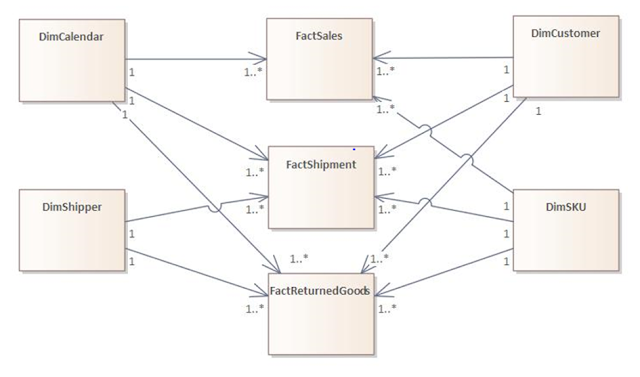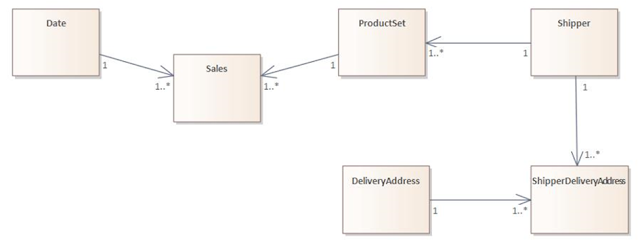Lingua Franca was involved in the data architecture of an organisation which name and type is of no interest for the case I am making. Namely, the way an organisation functions and is structured determines the data architecture. It is a text book example of many organisations today.
The organisation was a merger of various business units which all used their own proprietary business processes, data standards and data definitions.
The CIO had a vision of well governed, standardised processes that would create a unified organisation that operated in a predictable and transparent manner.
Harmonised End to End Processes Are the Basis of Transparent Decision Making
Shared facts and dimensions assure a scalable and manageable analytics architecture
The case for a Kimball approach in data
warehousing was clear: if every department, every knowledge unit would use the
same processes, the shared facts and common dimension architecture was a no
brainer.
As the diagram suggests: it takes effort to
make sure everybody is on the same page about the metrics and the dimensions
but once this is established, new iterations will go smoothly and build trust
in the data.
For more than 4 years, the resistance to
change wore the CIO, data warehouse team and finally the data architect out
when the CIO left the organisation. The new CIO decided to not continue the
fight for harmonised processes and saw this as a reduced need for a data
warehouse. If every business unit would use its own operational reporting, it
would produce rapid results at a far lower cost than a data warehouse
foundation delivering the reports. A new crew was on boarded: two ETL
developers, two front end developers and a data architect.
Satisfying Clients in Their Operational Silos Creates Technical Debt
As this diagram suggests, the client
defines his particular needs, asking for a report not on SKU level because he’s
only interested in product sets. The sets require special handling so they are
linked to specific shippers who have their delivery areas. Although this schema may cause no problems
for the frontend developer to produce a nice looking report, consolidating the
information on corporate level will take time and effort.
The reality will prove differently, of
course. If every business unit uses its own definitions, metrics and dimensions
there is no chance of having correct, aggregated information for strategic decision
making. To remedy this shortcoming, the new data architect will have to go back
to 2008, publish date of Bill Inmon’s DW
2.0. The idea is to create the operational report as fast as possible and after
delivering the product refactor the underlying data to make them compatible
with other data used in previous reports.
The result is a serious governance effort,
lots of rework and an ever growing DW 2.0 in the third normal form that one day
may contain sufficient enterprise wide data to produce meaningful aggregates
for strategic direction. The Corporate Information factory (CIF) revisited so
to speak.
Why the CIF Never Realised Any Value
In Inmon’s world, it was recommended to
build the entire data warehouse before extracting any data marts. These data
marts are aggregates, based on user profiles or functions in the organisation
and are groupings of detailed data that may change over time.
This led to many problems on the sites I
have visited during my career as a business analyst and data architect.
First and foremost: by the time you have
covered the entire scope of the CIF, the world has changed and you can refactor
entire parts of the data model and
reload quite a few data to be in synch with new realities. Doing this on a 3NF
data schema can be quite complex and time and resource consuming. And then
there is the data mart management problem: if requirements for aggregations
change over time, keeping track of historical changes in aggregations and
trends is a real pain.
About DW 2.0: the Data Quagmire
To anyone who hasn’t read this book: it’s the last attempt of the “father of data warehousing” to defend his erroneous Corporate Information Factory (CIF), adding some text data to a structured data warehouse in the third normal form. The book is full of conceptual drawings but that is all they are; not one implementation direction follows up on the drawings. Compare this to the Kimball books where every architectural concept is translated into SQL scripts and clear instructions and you know where the real value is.
With DW 2.0 the organisation is trying to
salvage some of the operational reports’ value but at a cost, significantly
higher than respecting the principle “Do IT right the first time”. The only
good thing about this new approach is that nobody will notice the cost overrun
because it is spread over numerous operational reports over time. Only when the
functional data marts need rebuilding, may some people notice the data quagmire
the organisation has stepped into.



Geen opmerkingen:
Een reactie posten